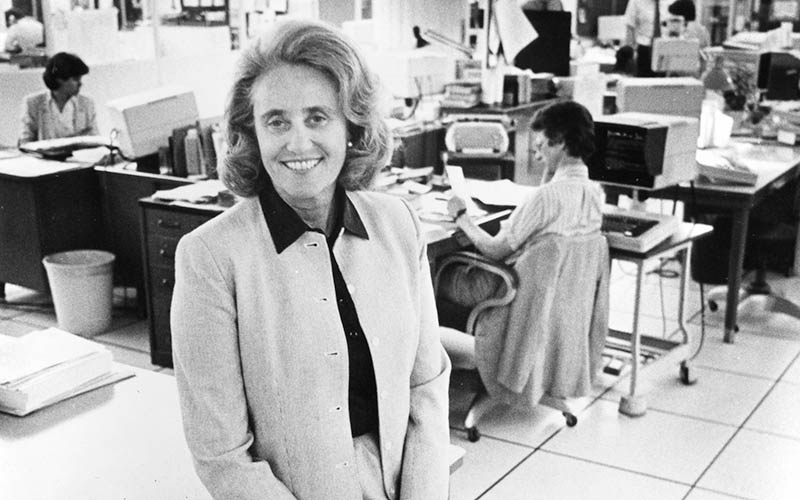Women of History: Katherine Fanning

Katherine Fanning, 1983. Photograph by Linda Payne.
© The Christian Science Monitor.
Katherine Woodruff Fanning became the Editor of The Christian Science Monitor on May 26, 1983.1 The former editor and publisher of the Daily News in Anchorage, Alaska, Fanning was the first woman to run a national newspaper, tasked with leading the Monitor into “a new phase in its growing usefulness to humanity.”2 Fanning would later refer to her new role as “a chance to combine my two great loves, newspapers and Christian Science.”3
Fanning’s journey to the Monitor’s offices in Boston was remarkable. Born on October 18, 1927, in Joliet, Illinois, she graduated from Smith College and married Marshall Field IV, whose family owned the Chicago Sun Times. She later credited this period with providing her informal education in journalism.4
Her marriage to Field ended in 1963. This marked one of the most trying times of her life. It was after her divorce that she began to seriously study Christian Science. She had been familiar with Christian Science since her youth, when her mother sought treatment for health problems.5, 6
Many who knew her would not have predicted the path that Fanning would take next. In 1965 she packed her three children into the car and moved the family to Anchorage. There she took a job as a librarian at the Daily News, at a salary of two dollars an hour. She was soon submitting articles, with her work frequently appearing on the front page.7 In 1967 she and her new husband, Larry Fanning, the former editor of the Chicago Sun Times, purchased the Daily News. They began pursuing investigative stories, including a 15-part series on the power and influence of the Alaska Teamsters Union, which won the 1976 Pulitzer Prize for Public Service.8
When Fanning came to the Monitor, she was tasked with shoring up the paper’s financial position and providing strong editorial leadership.9 She took a strong interest in the quality of the staff and worked to strengthen the Monitor’s position as a leader in international news. She also initiated improvements in the overseas bureaus, traveling to many of them herself.10
Fanning developed several major news series. One of the most significant was “Children in Darkness,” which explored child slavery and exploitation around the world. It appeared in the Monitor in June and July of 1987. When the story had been first brought to her in 1986, Fanning saw pursuing it as vital to the paper’s mission; she once said to a Monitor reporter, “We don’t accept that problems are insoluble.…We are not Pollyannas, but we do believe that there is good everywhere and we’re dedicated to improving the world by uncovering that good.”11
Fanning brought her unique experience and perspective to the story. For example, since the subject dealt with children who had likely been traumatized, she assembled an all-female team of investigative reporters, including Sara Terry, who believed that it was easier for the children to talk openly about their experiences when approached by women.12 The Boston Globe called this series, “the Monitor at its best: constructive journalism that explored international problems in the hope of ameliorating them.”13
In 1988 Fanning resigned from her role as editor of the Monitor “over budget and organizational changes….” However, she maintained an active involvement with the newspaper world, and with the Monitor in particular.14 When she passed away on October 19, 2000, Monitor editor David Cook observed: “[S]he went out of her way after leaving the editor’s job to help both individual writers and editors and to help the paper as a whole. We are enormously grateful to her for what she did while she was editor and for her many acts of kindness and care for the Monitor in recent years.”15
Listen to "The Christian Science Monitor—Genesis and Today," a Seekers and Scholars podcast episode featuring Monitor editor Mark Sappenfield.
- “Top editorial posts realigned at The Christian Science Monitor,” The Christian Science Monitor, May 26, 1983.
- The Christian Science Board of Directors, “From the Directors,” Christian Science Sentinel, October 3, 1983.
- David T. Cook, “Katherine W. Fanning: A pioneer in American journalism,” The Christian Science Monitor, October 23, 2000.
- Edward Wong, “Katherine W. Fanning, 73; Pioneering Newspaper Editor,” The New York Times, October 23, 2000.
- Keith S. Collins, The Christian Science Monitor: Its History Mission and People (n.p., Nebadoon Press, 2012), 230-231.
- Wong, “Katherine W. Fanning.”
- Wong, “Katherine W. Fanning.”
- Collins, The Christian Science Monitor, 232-233.
- Ibid., 236-237.
- Cook, “Katherine W. Fanning.”
- Cook, “Katherine W. Fanning.”
- Collins, The Christian Science Monitor, 248-250.
- Daniel Golden, “Can Mary Baker Eddy’s Church Heal Itself?” Boston Globe, May 17, 1992.
- Cook, “Katherine W. Fanning.”
- Tom Long, “Obituaries, Katherine Fanning, at 73; editor known as trailblazer,” The Boston Globe, October 21, 2000.

